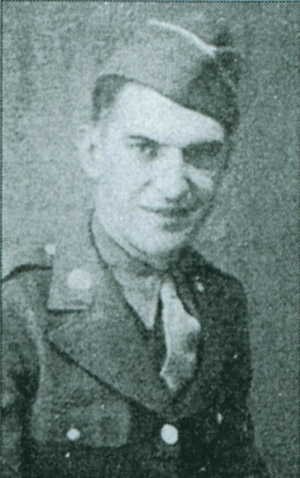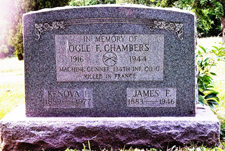

Remember...
Ogle Ferguson Chambers
1916-1944
"We know that enduring peace cannot be bought at the cost of other people's freedom."
Franklin D. Roosevelt
 |
Remember...Ogle Ferguson Chambers
|
Ogle Ferguson Chambers was born on December 3, 1916, at Logan, West Virginia, according to his Logan County birth certificate. The family lived on Whitman Creek. Ogle's father, James, worked in the coal mines, and his mother, Kenova, was a homemaker. By 1920, according to the U.S. Federal Census, the Chambers family included Ardeth, Irona , Aretta, and Ogle. The family would grow over the next decade to include Thurman and James Jr. By the time of the 1930 census, the family lived in Riverside Town, Monongalia County, apparently following employment in the mines. James Sr. was a track layer. Ogle was 12 and attending school. His sisters also worked outside the home, one as a telephone operator and another in sales.
In 1940, Ogle, Thurman, and James Jr. were still living at home, and the family still resided in Riverside. Of those siblings, only Ogle and James Jr. had jobs, with Thurman presumably still in school. Ogle worked as a trackman in the mines, and James Jr. worked as a janitor.
On December 20, 1943, Ogle enlisted in the military in Clarksburg. In a few short months, he was in France. He was an army private first class in the 35th Infantry Division, 134th Infantry Regiment, 2nd Battalion, Company G. Ogle Chambers was a machine gunner.
No record was found that details when Ogle Chambers joined the 134th Infantry Regiment. The regiment arrived in France, via England, in July 1944, so this would be Ogle Chamber's story, if he was with them from the beginning of the mission.
Major General Butler Miltonberger, Former Commanding Officer, 134th Infantry Regiment, and Major James A. Huston, Assistant Professor of History, Purdue University, have preserved the history of the 134th Infantry Regiment in their Combat History of World War II. The motto of the 134th was "All Hell Can't Stop Us." Chapter VII details the role of the 134th in the "Gremecy Defensive." (Accessed 14 April 2017, http://www.coulthart.com/134/chapter_7.htm.) Chapter VIII follows up with "Through Lorraine to Germany," and from these accounts we can infer what happened to Ogle Chambers. (Accessed 14 April 2017, http://www.coulthart.com/134/chapter_8.htm.)
Chapter VIII describes in detail the Battle of Achain. The push through the Lorraine region of France to Germany began on November 8 with the 134th in reserve. This wouldn't last long, and the 134th joined the next series of goals the day after it began. In this series, the first objective was to take Coutures. Since winter was coming and the weather was turning cold, getting troops, and their commanders, to villages and buildings was a focus. Mines hindered the route to the Bois de la Marchande. Artillery fire was another hazard as the 35th fought its way to Amelecourt. On November 11, the 35th Infantry Division in the year 1944 was not far from the location of the 35th of 1918: Lorraine. As it made its way to the next villages, the men of the 134th began fighting tanks with only infantry men, guns, and grenades. Fighting on the 11th extended into the night. During most of the 12th, there was no resistance, as the Germans withdrew, until near the end of the day. The advance on retreating Germans ended on November 13 in three bloody battles. The 1st Battalion suffered "Blue Monday" on Red Hill, and the 3rd Battalion engaged in a difficult attack on Pevange. The 2nd Battalion, with Company G of the 134th, went to Achain.
According to Miltonberger and Huston, Companies I and G were "finding the fighting as difficult as were the others. Again, German defenders had established themselves in an orchard, and their intense and accurate small arms fire was a definite deterrence for men trying to reach the town." Sometime during the fighting on the 13th, Ogle Chambers was killed.
Attack! is a small booklet covering the history of the 35th Infantry Division. This booklet is one of the series of G.I. Stories published by the Stars & Stripes in Paris in 1944-1945. Like Miltonberger and Huston's account, Attack! describes the push from foxhole front-line positions near St. Nicholas all the way into Germany, crossing 1,300 miles. It chronicles a series of terrible, brutal battles and a large, punishing campaign. (Accessed 14 April 2017, http://www.lonesentry.com/gi_stories_booklets/35thinfantry/.)
According to Attack!:
Once the opposition was cleared from the west bank, the 35th's task would be to cross the Rhine. The task of spearheading Ninth Army befitted an infantry outfit which had traveled a rough, twisting road more than 1300 miles long through France, Belgium, Luxembourg, Holland and into Germany. It had fought in eight different Corps, in four American Armies on the Western Front. With nearly 6000 prisoners taken in the latest operation through March 11, the 35th's total PW haul since D-Day topped the 17,000 mark.Division officers and men had won approximately 3000 awards including the Medal of Honor, Distinguished Service Cross, Silver Star, Bronze Star and Legion of Merit, and had shed blood for many Purple Hearts. Approximately 100 enlisted men had received battlefield commissions.
The Battle of Achain was also known for the actions of another soldier with West Virginia ties: James Spurrier Jr., known as "Junior" Spurrier. Spurrier was the leader of the squad and was awarded a Medal of Honor for his actions that day. He was known as "Task Force Spurrier, the One-Man Army." Both Attack! and Combat History describe the liberation of Achain as a one-man effort, with Spurrier single-handedly attacking the Germans occupying the town, returning to the command post with prisoners and for ammunition, when necessary.
Other West Virginians of note with the 35th were Pvt. Clyde Smith, Sgt. William Zais, and Staff Sergeant Thomas Wese.
The 35th would go on without Pfc. Chambers.
Ogle's father died only two years after Ogle. James Sr. died of silicosis, per the doctor's finding, in 1946 after many years working in the mines.
| Ogle Chambers' body was returned home in 1948. He, his father, and his mother are interred in East Oak Grove Cemetery in Morgantown. |  Headstone, courtesy Cynthia Mullens |
Article prepared by Cynthia Mullens, with editorial assistance from Patricia Richards McClure
April 2017

West Virginia Archives and History welcomes any additional information that can be provided about these veterans, including photographs, family names, letters and other relevant personal history.